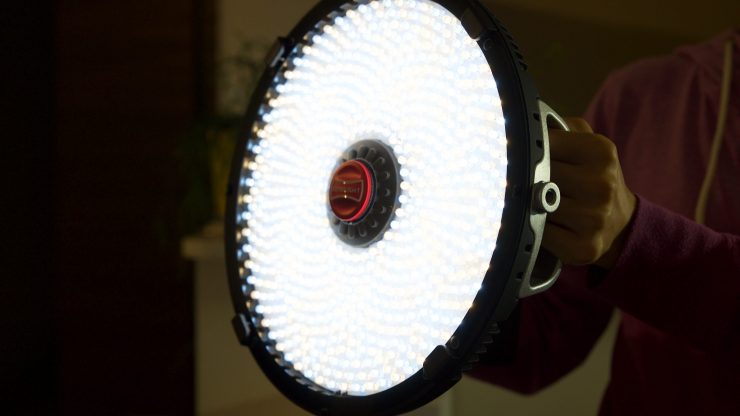
Rotolight’s AEOS is a a lightweight, power efficient, colour temperature adjustable LED light with an impressive range of features. With so many LED panel lights on the market you really do need to do something special to have any chance of standing out. I have recently been putting the AEOS through its paces to see if it’s more than just another LED light.
It’s all Greek to me

The origin of the name “AEOS” is from ancient greek mythology, and like any Greek mythological name, there’s a great story behind it. Helios was the Greek god of the sun and each day he drove a chariot across the sky and circled the earth. Pulling his chariot were four Pegusi, one of which was named “AEOS.”
If it ain’t broke don’t fix it
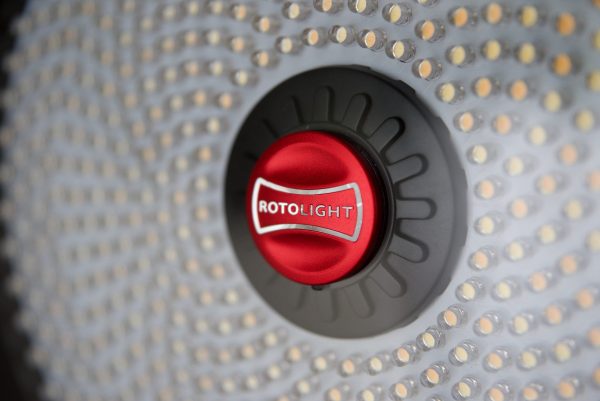
The previous Anova Pro was a great light, so Rotolight didn’t need to go and re-invent the wheel. All they did was take the same concept and turn it into a much lighter and more power efficient version.
Weight and size
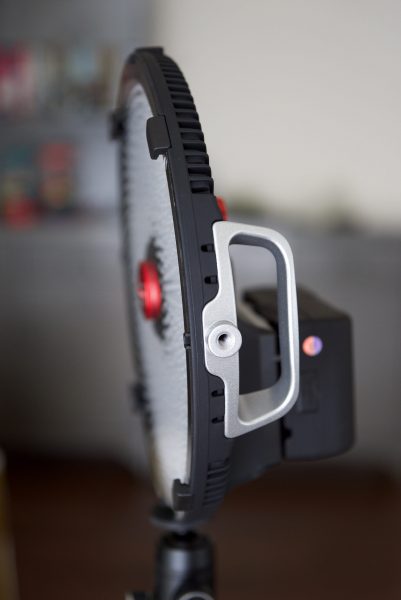
The AEOS weighs 1.4kg (3lb), and Rotolight claim that at just 2cm (0.78″) thick, it’s one of the most portable lights on the market. You do need to keep in mind that the 2cm of thickness only applies to the actual panel. If you measure the light out to its deepest point, which is the built-in battery plate, the light is closer to 8cm (3.14″). This is still considerably thinner and lighter than most other 1×1 panels such as the Litepanels Astra 4X Bi-Color which is 13.46cm (5.3″) thick and weighs 3.2kg (7lb).
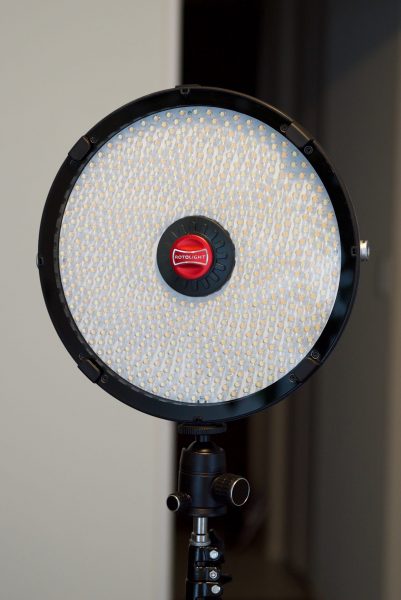
Most traditional 1×1 LED panels as the name implies are 1ftx1ft. The AEOS is not square, but round. Its 29.5cm diameter is very comparable to that of a 1×1 LED panel, but in a much lighter package. Of course if you do want an even lighter and thinner 1×1 LED then flexible panels from companies such as Westcott and Aladdin are available, but they don’t produce nearly as much output.
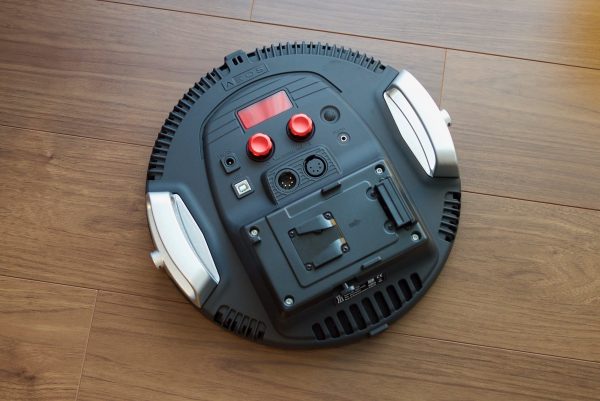
For anyone who travels a lot, weight is a constant concern. Excess baggage charges are not cheap and every pound you can save keeps more money in your pocket. This makes the AEOS a compelling solution for shooters who would like to use LED panel lights, but were perhaps using other options because they were worried about the weight.
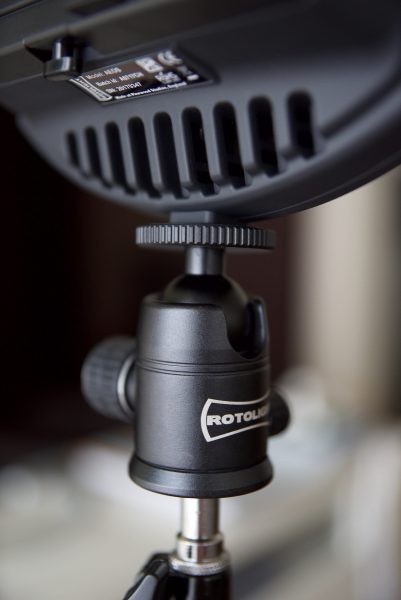
The other big benefit of the AEOS only weighing 1.4kg is that you can attach the light to the included aluminium ballhead. By doing this it gives you a lot more possibilities for lighting angles, shadow control and creative manipulation of the light. Because most other LED panels weigh in around 3-4kg – they have been too heavy for ballheads, so you had to use a yoke frame. The problem with yoke frames on any panel, is they typically limit the tilt to around 30 degrees.
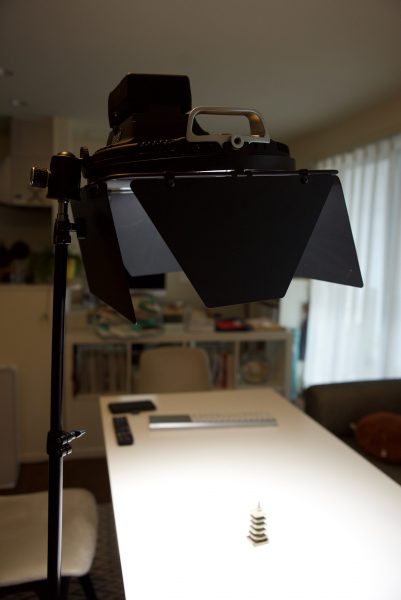
I found that even with the optional barn doors and Rotolight’s V-lock battery that I could attach the light to the ball head and angle it at 90 degrees. This is very handy and allows you to use the light for so many different shots.
Not having to carry around a big yoke frame also allows the AEOS to be packed into smaller bags which is always handy when you are travelling.
Power draw, or more precisely the lack of
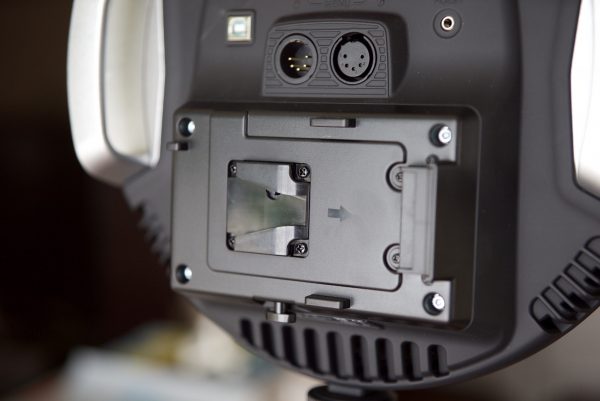
I wouldn’t normally talk about power draw so high up in a lot of lighting reviews, but it’s one of the AEOS’s biggest strengths. The light draws just 42W. No that’s not a typo it’s just 42W. This is considerably less than most other 1×1 panel lights such as the Litepanels Astra 4x Bi-Color and Astra 6x Bi-Color lights which draw 110W and 105W respectively.
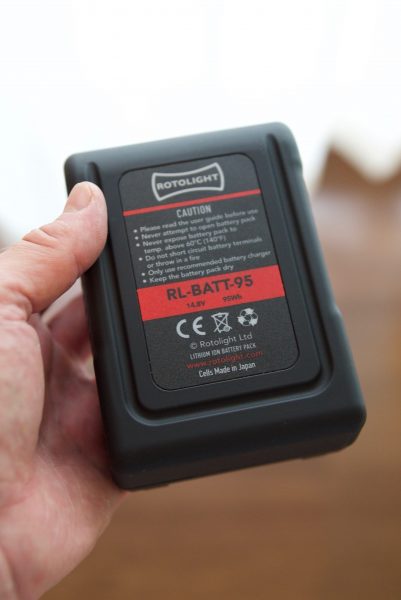
So what does this actually mean? Well if you are running the AEOS off a 95Wh V-lock battery you can do so at full output for hours and hours. If you use that same battery on a Litepanels Astra you can’t even run the light at 100% output because of the power draw, and you would be looking at a run time that was considerably less than the AEOS. This low power draw is quite extraordinary given the fact that the AEOS draws less power than the companies ANOVA Pro.
If you combine the lightweight nature of the AEOS with its low power draw it looks to be a good solution for news crews or shooters who travel a lot and need to keep their excess baggage to a minimum. The ability to take a light on location and be able to run it off a camera battery at full power for long periods of time using a travel-friendly battery is something that shouldn’t be taken lightly.
Build quality
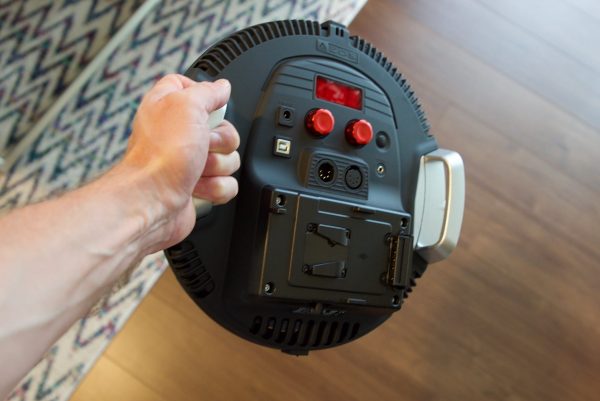
Despite the low weight the AEOS is solidly made. The casing feels robust and the built-in aluminium handles are a nice touch and allow you to have someone hold the light for you if you are moving around with the camera.. The switches and dials are all solid to the touch and the front acrylic plate that allows you to put in a range of Rotolight’s own filters is also well made.
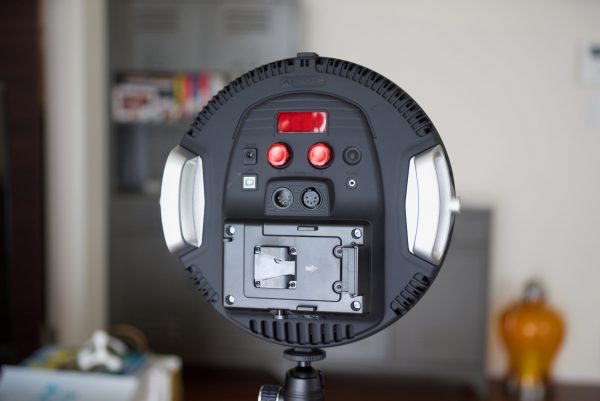
An optional yoke frame locks in solidly onto the sides of the handles and you can tighten the light down so it doesn’t move at all.
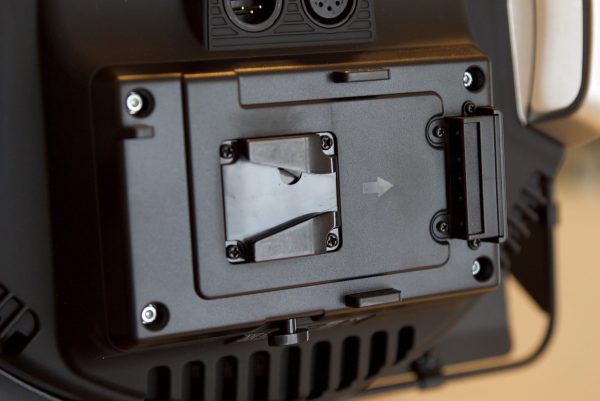
The light comes with a built in V-lock battery plate (why some manufacturers make this an optional extra on so called portable field lights is beyond me), which makes a lot of sense given the light’s low power draw and who it’s aimed at.
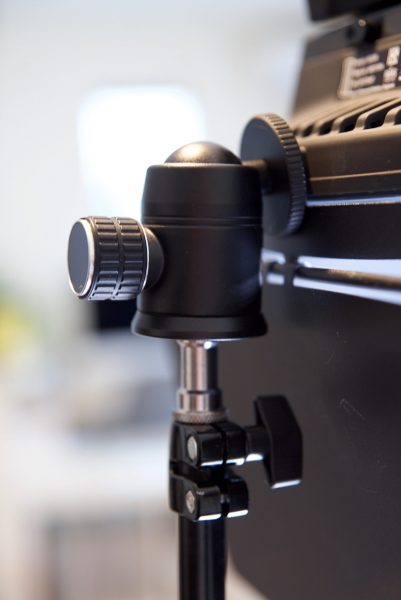
The included ballhead is extremely robust and easily supports the weight of the Rotolight even if you have a V-lock battery and barn doors attached.
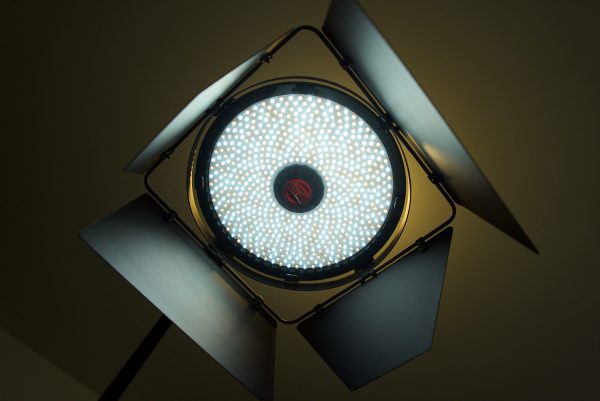
The optional barn doors are solid and don’t rattle around on the light. The only problem I have with the barn doors is that they don’t rotate. This is a minor complaint but it does give you slightly less control over your light’s spill.
Physical Controls
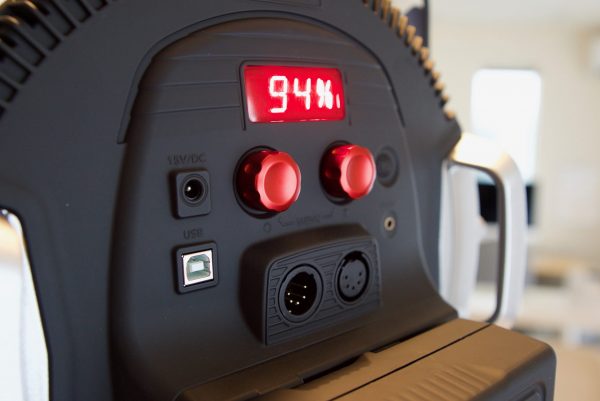
If you are familiar with any of Rotolight’s other offerings, you will know that the physical design and layout of the controls is standard across all of their models. This is not such a bad thing as you can jump from one model to the next and know exactly how to use and control the light.
If you haven’t used a Rotolight before, the control over colour temperature and output is easy, but it may take you a little bit of time to get used to using the light’s more advanced features.
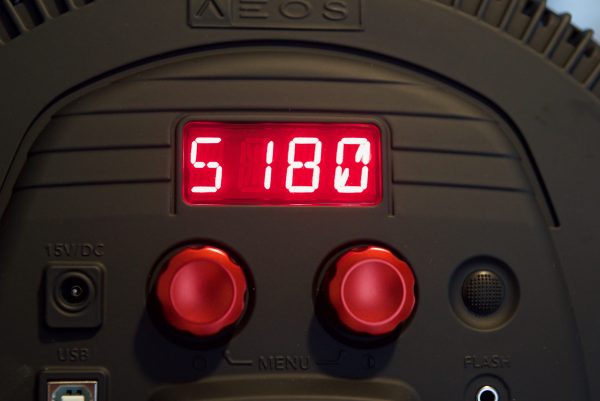
The light can be adjusted from 3150K up to 6300K in increments of 10K. You can also hold the dial down and move it if you need to do it quicker. The light can also be dimmed from 100% to 1% in 1% increments. Again if you hold down the dial and move it it does it a lot quicker.
The light has 15V DC input, DMX in and out, a port for flash control, and a USB port.
SFX and inbuilt flash sync port
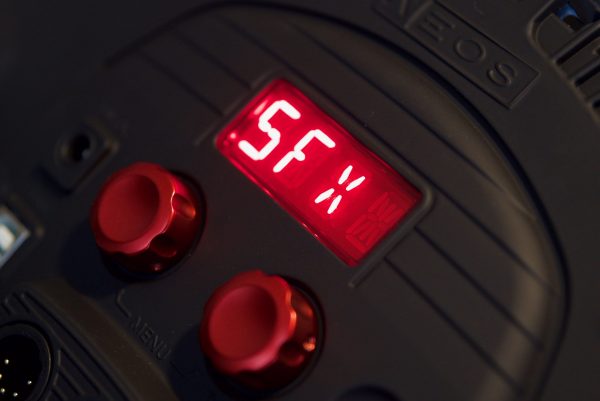
Like previous Rotolights, the AEOS features the company’s CineSFX, Designer Fade, and True Aperture Dimming. These are all very useful features to have, and allow you to recreate effects that normally would require specialist equipment. These include Strobe, Lightning, Fire, Cycle, Throb, Police, and TV. These can be remote triggered using either a wired DMX trigger, or wirelessly using the PC sync port on the back of the light.
True Aperture Dimming calculates and displays the correct aperture (F-Stop) for your subject at a given distance. In theory this eliminates the need for using a light meter in certain situations. You can also adjust your brightness level, to coincide with your desired aperture (F-Stop). It is unfortunate that it doesn’t also show T-stops for those using the light with cinema lenses. The Designer Fade effect lets you dial in preset times for custom fade up / fade downs which can be handy for certain projects.
The AEOS also features the same flash sync port that was introduced on the Anova PRO. This allows a stills photographer to use the AEOS in place of a strobe and it does so with no recycle time and in high speed sync. When in flash sync mode, the light is able to flash at 200% of its maximum continuous output (the Anova Pro could only do 150%). Now this is not going to be nearly as powerful as most strobes, but it is certainly useful for some shoots.
For those who are shooting both stills and video, this product goes some way towards eliminating the need for two separate purchases and removes many of the constant downsides of shooting with strobes (e.g. your flash not firing because of recycle time). If your job calls for both stills and video, or you’re working in multimedia, this function alone makes the AEOS worth considering.
Photometrics
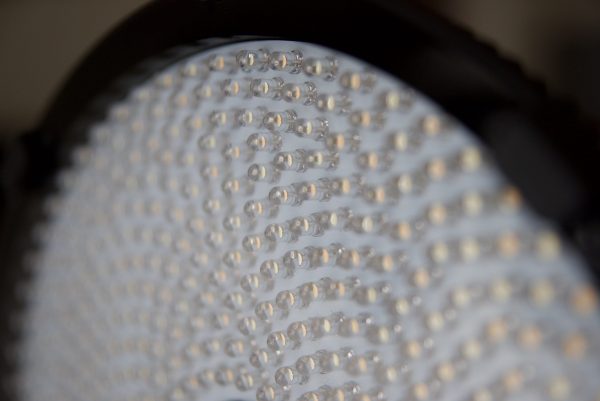
So the low power draw, compact size and in-built SFX are all great, but how does the light actually perform? As always I used a Sekonic C-700 to measure the light’s photometrics and I started off by seeing how much output the AEOS had when it was set at 5600K at a distance of 1 metre.
Output and kelvin colour temperature
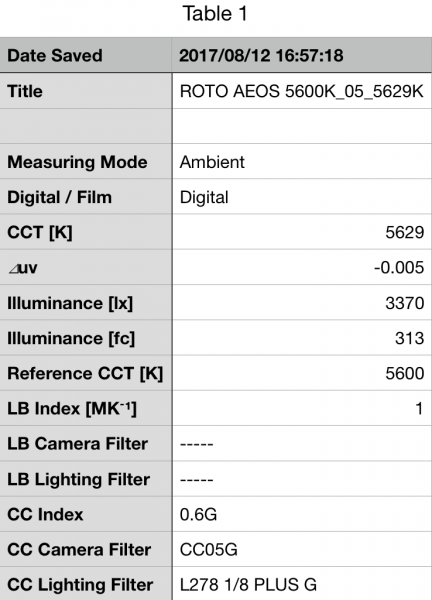
As you can see from the above figures the AEOS output 3370lx at a distance of 1 meter when it was set at 5600K. It recorded a kelvin colour temperature of 5629K and a ⊿uv score of -0.005 (⊿uv is the value to show how much this light is away from being an ideal light source (black body radiation = incandescent lamp). The AEOS also recorded a CC Index of 0.6G. The CC Index displays the CC correction value and whether any magenta or green need to be added or subtracted. 1 CC corresponds to 035 Kodak CC values or 1/8 Rosco filter values. Any reading less than +1.00 or -1.00 and you’re probably not going to need to make any kind of adjustment. The AEOS is very good at reproducing a 5600k source, but the output was a little low when you compare it against some other 1×1 panel lights.
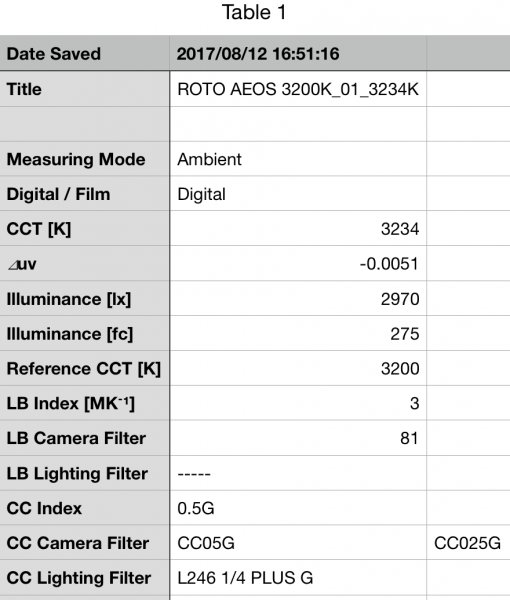
Above you can see the figures for the AEOS when it was set at 3200K. The light outputted 2970lx at a distance of 1 meter and recorded kelvin colour temperature of 3234K. The ⊿uv score was -0.005 and the CC Index was 0.5G. As with most kelvin temperature adjustable LED lights the AEOS lost a bit of output compared to when it was set at 5600K. It was however, very good at reproducing a 3200K source.
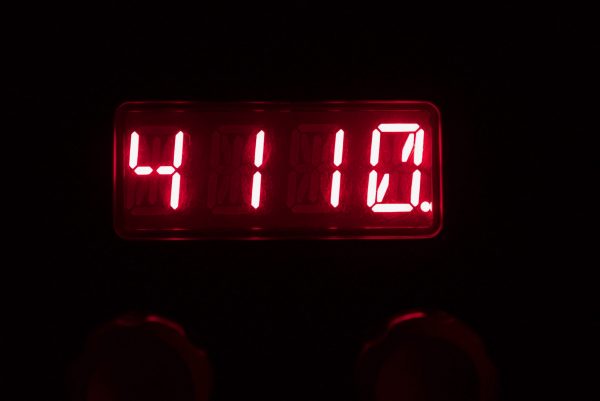
Rotolight provide a nice feature on the AEOS where a little red dot comes up on the LCD display that tells you when the light is set at the optimum kelvin colour temperature to produce the most amount of output. I found that the maximum amount of output occurred when the light was set at 4110K.
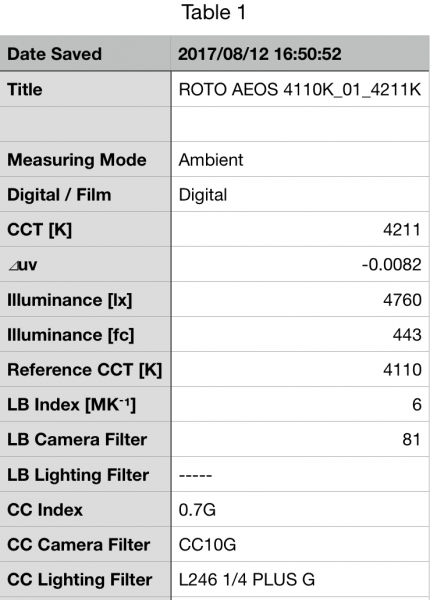
Above you can see the figures for the AEOS when the light was set at 4110k. It output 4760lx at a distance of 1 metre, and recorded a kelvin colour temperature of 4211K. The ⊿uv score was -0.0082 and the CC Index was 0.7G. The output of 4760lx is still sufficient for lighting interviews and a lot of ENG appplications. Again the light was very good at replicating the colour temperature it was set at.
Here are the results for the lights output when tested at various kelvin colour temperatures:
3200k- 2970lx
4110k- 4760lx
5600k- 3370lx
6300k- 2690lx
Here are the results for how well the light re-produced the kelvin colour temperature it was set at:
3200K- 3234K
4110K- 4211K
5600K- 5629K
6300K- 6450K
So how does the output compare to some of its competition?
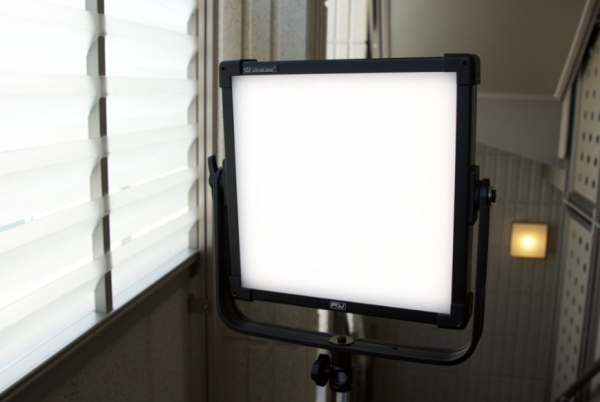
Even though the AEOS doesn’t have an in-built diffusion panel, the light it outputs is pretty soft for a 1×1 style panel light. Therefore I’ll give you some figures of how it compares to other 1×1 panel lights that have an in-built diffusion panel.
5600K (at a distance of 1m)
Rotolight AEOS– 3370lx
Litepanels Astra Bi-colour Soft– 3000lx
F&V Z400S– 3730lx
BB&S Area 48 Soft– 3290lx*
3200K (at a distance of 1m)
Rotolight AEOS- 2970lx
Litepanels Astra Bi-colour Soft- 2200lx
F&V Z400S- 2020lx
BB&S Area 48- 3000lx*
*The BB&S Area 48 is not a bi-colour light and you need to use different remote phosphor panels to change the colour temperature.
Just for your information this is how much power each of the lights draw:
Rotolight AEOS- 42W
Litepanels Astra Bi-colour Soft- 110W
F&V Z400S- 90W
BB&S Area 48 Soft- 122W
Here is the beam angle of all the lights:
Rotolight AEOS- 50°
Litepanels Astra Bi-colour Soft- 93°
F&V Z400S- 130°
BB&S Area 48 Soft- 160°
Colour Rendering
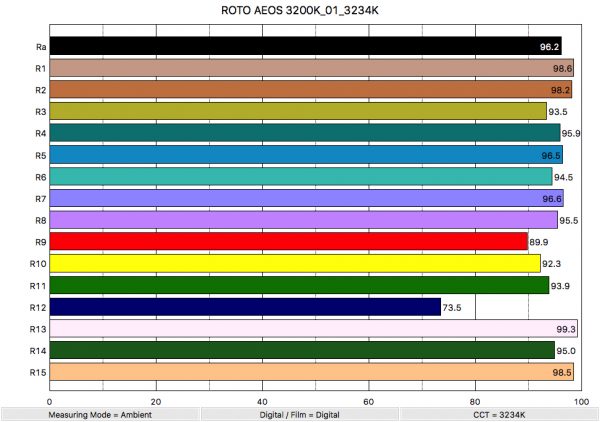
I also used the Sekonic C-700 to measure the light’s ability to accurately reproduce colours. Above you can see the colour rendering results when the light was set at 3200K. The light recorded an average CRI (R1-R8) of 96.2 and an extended CRI (R1-R15) of 94.1. For replicating accurate skin tones it recorded 89.9 for R8 (red), 99.3 for R13 (closest to white skin tones), and 98.5 for R15 (closest to asian skin tones). These are excellent results.
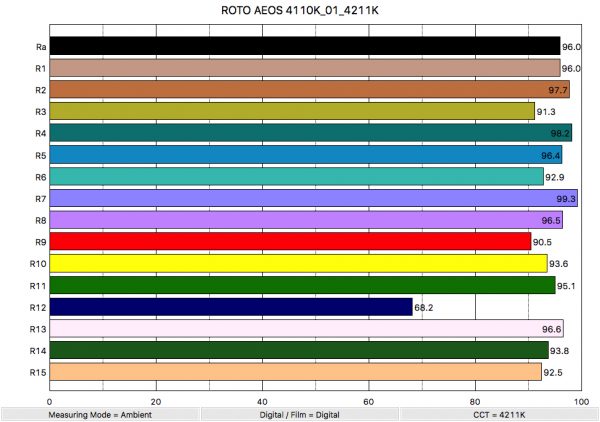
Above you can see the light’s colour rendering scores when I tested it at 4110K (where it has the most output). The light recorded an average CRI (R1-R8) of 96.0 and an extended CRI (R1-R15) of 93.2. For replicating accurate skin tones it recorded 90.5 for R8 (red), 96.6 for R13 (closest to white skin tones), and 92.5 for R15 (closest to asian skin tones).
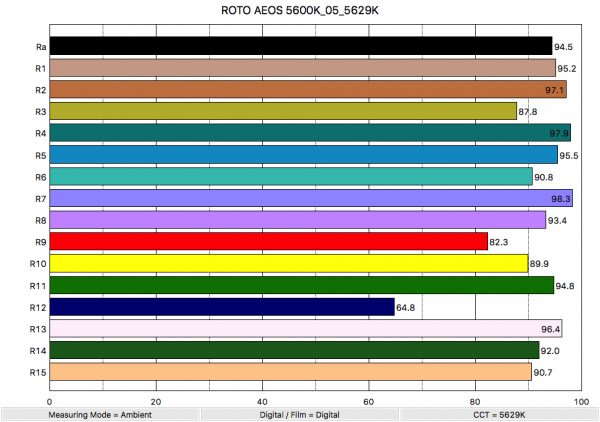
Above you can see the lights colour rendering scores when I tested it at 5600k. The light recorded an average CRI (R1-R8) of 94.5 and an extended CRI (R1-R15) of 91.1. For replicating accurate skin tones it recorded 82.3 for R8 (red), 96.4 for R13 (closest to white skin tones), and 90.7 for R15 (closest to asian skin tones).
Below you can see a summary of the results:
3200k- Extended CRI (R1-R15) 94.1
4110k- Extended CRI (R1-R15) 93.2
5600k- Extended CRI (R1-R15) 91.1
6300k- Extended CRI (R1-R15) 90.6
So how does the colour rendering compare to some of its competition?
5600K (extended CRI figures)
Rotolight AEOS- 91.1
Litepanels Astra Bi-colour Soft- 92.5
F&V Z400S- 93.6
BB&S Area 48 Soft- 91.2
3200K (extended CRI figures)
Rotolight AEOS- 94.1
Litepanels Astra Bi-colour Soft- 97.3
F&V Z400S- 95.5
BB&S Area 48 Soft- 96.0
How does the AEOS perform against its competition in a real world scenario?
As Rotolight claim that their light should be compared to other soft source LED panel lights I decided to do a head to head shootout (or should it be a lightout?) between the AEOS, Litepanels Astra Bi-colour Soft, F&V Z400S, and BB&S Area 48 Soft.
I set up a typical scene that you may well encounter when going in to someone’s house to film. All of the lights were placed in the same position and set at 5600K. There is a backlight being used, but I didn’t change that light’s output or position for any of the tests.
For the first test I white balanced for each light used and varied the output to get correct exposure. No diffusion was used as I wanted to test these lights to see how they looked if you buy the base unit and use it straight out of the box. In the second test I used a preset 5600K 0.0CC white balance on the camera so you can see the differences between all the lights. I’ll leave the conclusions to you as to which light you thought looked the best. Let us know in the comments section at the bottom of the article.
It’s important to remember that all these light will look different depending on what camera and lens combination you are using as well as what type of skin tone your subject has.
In the last test I set the lights to 100% output so you can compare their beam spread and intensity. In terms of the beam spread, the BB&S Area 48 is capable of lighting up a lot larger area than any of the other lights. Then comes the Litepanels Bi-Color Soft, F&V Z400S and finally the Rotolight AEOS. It is no surprise that the AEOS couldn’t light up large areas given its very narrow 50° beam angle. The benefit of only having a 50° beam angle means the light doesn’t create a lot of spill and you can use it for interviews without the need for barn doors or soft boxes with egg crates.
Even though when I tested all four lights output at a distance of one meter the results were fairly close, in the real world that was not the case. Again the BB&S lead the pack in terms of overall intensity, followed by the Litepanels, then very closely by the F&V, and finally the Rotolight.
So how is the light to use?
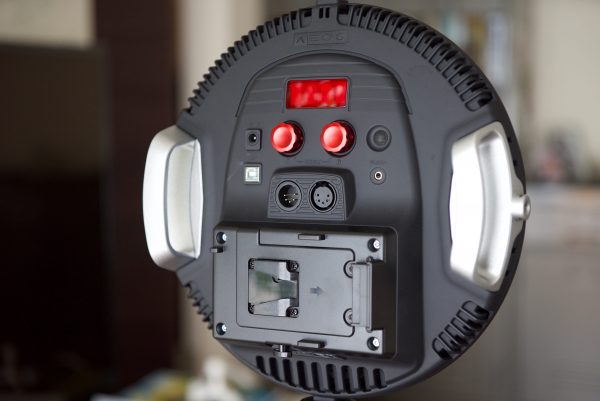
As I mention in every lighting review, the numbers only tell part of the story. Making changes to the output and colour temperature is very straightforward and the LCD display lets you accurately monitor and see any changes that you make. Changing filters is quick and easy and the built in V-lock battery plate and low power consumption allow you to run the light off a camera battery for long periods of time. This also makes moving the light around easy, as you’re not having to look for power outlets and run long extension cables across the floor.
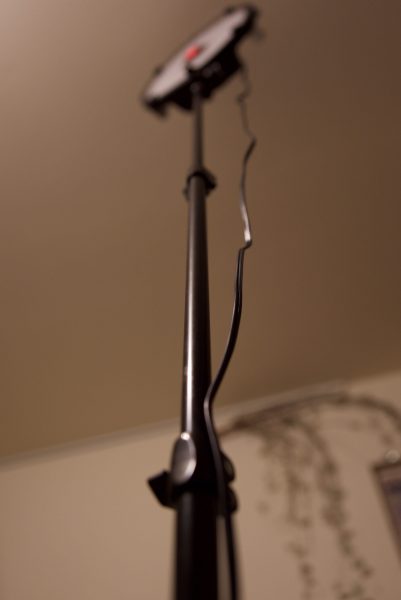
If you do want to run the light off mains power then Rotolight includes a power supply and also a nice extension cable that you can use to extend the length of the cord that runs from the light to the power supply. This is very handy if you have the light up high or out on a C-stand and you don’t want to have the power supply dangling around in the air.
As you can use the light on the ball mount and don’t need to use it on a big yoke the AEOS is easy to fit into smaller areas and it doesn’t take up a lot of space in a room.
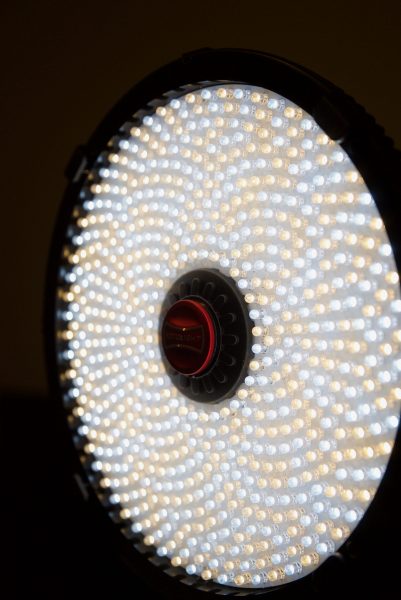
I like how the light replicates skin tones and you can create a really nice soft source (but be warned it’s not that bright) by combining a couple of the diffusion filters. My favourite combination is to use the 255 Hollywood frost (optional) with the 216 White Diffusion (included). This is a nice option but you need to have the light quite close to someone to use it in this capacity as the output at 5600K gets knocked down to just 1000lx at distance of one metre.
What do you get in the basic kit and what are the optional extras?
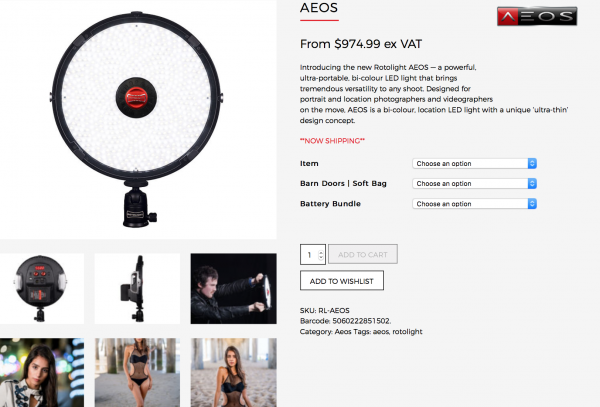
The standard light, which costs $974.99 US, comes with the AEOS fixture, Professional 360 Ball Head, four pack of filters (3/4 diffusion, 1.5 stop diffusion, 184 cosmetic peach skin tone, and a magenta filter for matching to fluro/tungsten light sources). You also get a filter holder and mains power supply. It also has an built-in V-mount battery plate.
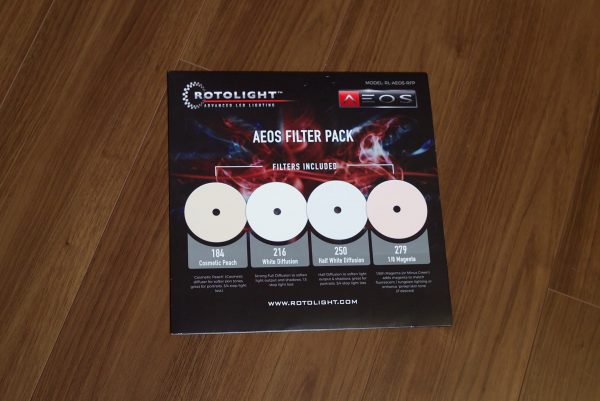
There is also a two light kit which consists of two AEOS Location LED Lights, two portable light stands, a dual LED soft carry case, two four-filter packs, and two ballheads for $2,059.99 US
Optional extras:
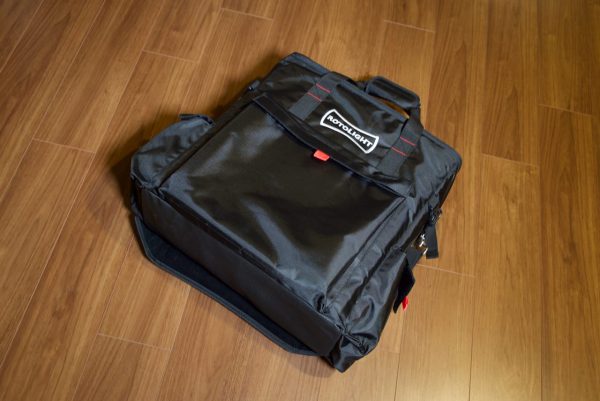
Four-leaf barndoors- $194.98 US
95Wh V-Mount Lithium Ion battery with D-Tap connector and travel charger- $335 US
Rotolight Dual LED Light AEOS soft carry case – $164.99 US
The optional Dual LED Light AEOS soft carry case is really well made and if you just use it for a single fixture you can fit all the accessories you need, including a light stand.
Here is what the competitors are priced at:
Litepanels Astra Bi-colour Soft- $1,425US (includes: Litepanels Astra 1×1 Bi-Color, manual yoke, power supply and US & EU power cords) Optional extra: V-mount battery plate ($148.50)
F&V Z400S- $1,099 US (includes: UltraColor Z400S Bi-color panel, V-Mount AC adapter)
BB&S Area 48 Soft- $2,295 US (includes: 3200K or 5600K High CRI Phosphor Panel, detachable barn doors, angled yoke with 5/8″ female baby/junior combo TVMP, 160 Watt power supply & AC power cord. Optional extra: V-mount battery plate ($289.00US)
Final thoughts
The AEOS certainly does offer a lot of functionality at a very reasonable price. The build quality is very good, and the power output while not high, is impressive given the light’s small power draw. For news and documentary shooters, the ability to run the AEOS off a 95Wh camera batteries for long periods of time at full power is a big selling point. The light is colour accurate and very good at replicating skin tones correctly. It is also excellent at reproducing the correct colour temperature across its 3150-6300K range.
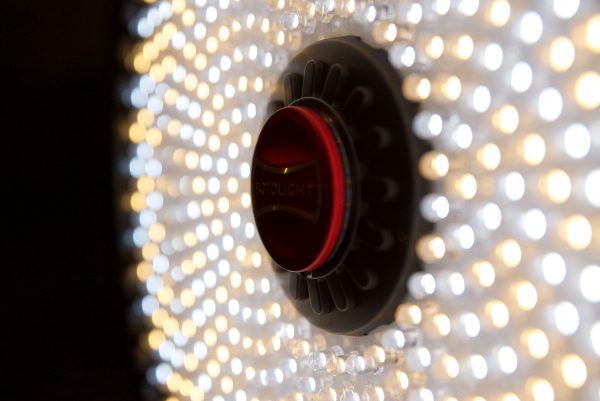
My only niggling concern about the AEOS was that I feel it is slightly underpowered compared to some of the 1×1 panel lights that are available. Even though Rotolight claim it should be compared to other soft source 1×1 panel lights, it doesn’t have an in-built diffusion panel like the lights I tested it against. If you do put diffusion in front of the light the output is much lower than those other lights. Yes, they could have made the light with a greater output, but then that would of come at the expense of a higher power draw. The other downside it has is when you compare it to the competition is it has quite a narrow beam angle which doesn’t make it suitable for lighting up bigger spaces.
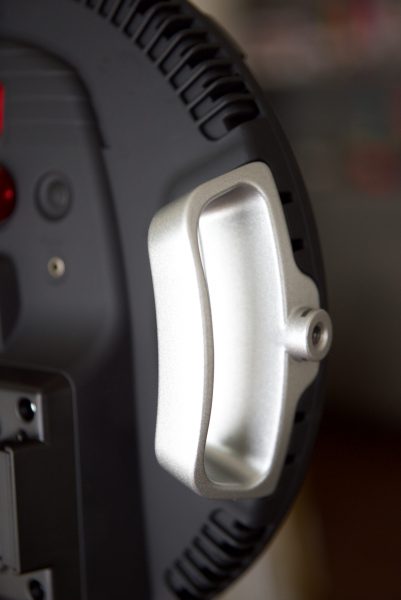
Given the light is targeted pretty much directly at news crews and shooters who travel a lot, it’s fair to say Rotolight have tried to make a good compromise between output and run times.The AEOS is much more suitable for using as a key interview light than it is for lighting up large spaces. To be honest there are very few if any 1×1 panel lights available that you can use for every lighting scenario. A 1×1 panel is never going to replace a HMI, but some of the high output choices that are available can make for a good alternative.
I really like the AEOS. The low power draw is a killer feature that other companies offering similar solutions just can’t compete against. The AEOS is well priced, and the low weight, compact size, and ability to use a ball mount instead of a large yoke all help make the AEOS a very good choice for shooters who travel a lot and want to keep their gear to a minimum.
What do you think about the Rotolight AEOS? What 1×1 panel lights do you use? Let us know in the comments section below.





